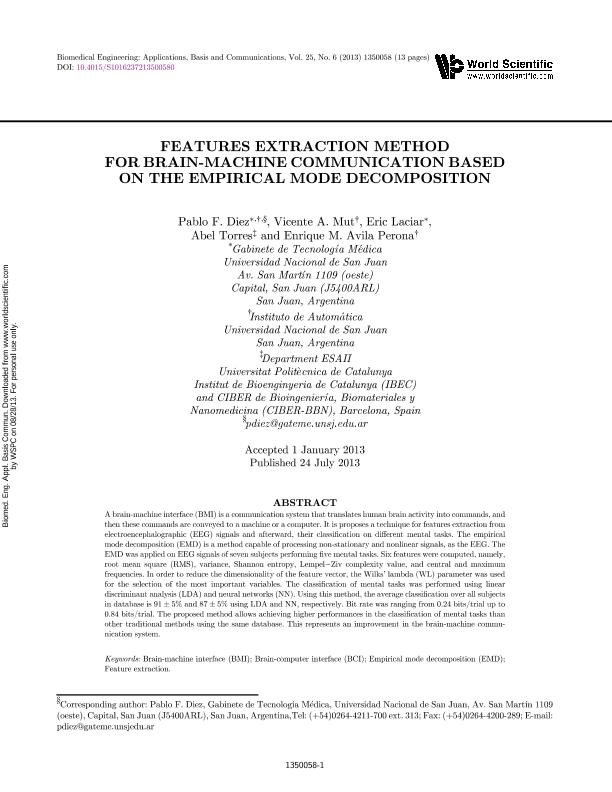Artículo
Features extraction method for brain-machine communication based on the empirical mode decomposition
Diez, Pablo Federico ; Mut, Vicente Antonio
; Mut, Vicente Antonio ; Laciar Leber, Eric
; Laciar Leber, Eric ; Torres, Abel; Avila Perona, Enrique Mario
; Torres, Abel; Avila Perona, Enrique Mario
 ; Mut, Vicente Antonio
; Mut, Vicente Antonio ; Laciar Leber, Eric
; Laciar Leber, Eric ; Torres, Abel; Avila Perona, Enrique Mario
; Torres, Abel; Avila Perona, Enrique Mario
Fecha de publicación:
07/2013
Editorial:
World Scientific
Revista:
Biomedical Engineering-applications Basis Communications
ISSN:
1016-2372
e-ISSN:
1793-7132
Idioma:
Inglés
Tipo de recurso:
Artículo publicado
Resumen
A brain-machine interface (BMI) is a communication system that translates human brain activity into commands, and then these commands are conveyed to a machine or a computer. It is proposes a technique for features extraction from electroencephalographic (EEG) signals and afterward, their classification on different mental tasks. The empirical mode decomposition (EMD) is a method capable of processing non-stationary and nonlinear signals, as the EEG. The EMD was applied on EEG signals of seven subjects performing five mental tasks. Six features were computed, namely, root mean square (RMS), variance, Shannon entropy, Lempel-Ziv complexity value, and central and maximum frequencies. In order to reduce the dimensionality of the feature vector, the Wilks´ lambda (WL) parameter was used for the selection of the most important variables. The classification of mental tasks was performed using linear discriminant analysis (LDA) and neural networks (NN). Using this method, the average classification over all subjects in database is 91 ± 5% and 87 ± 5% using LDA and NN, respectively. Bit rate was ranging from 0.24 bits/trial up to 0.84 bits/trial. The proposed method allows achieving higher performances in the classification of mental tasks than other traditional methods using the same database. This represents an improvement in the brain-machine communication system.
Archivos asociados
Licencia
Identificadores
Colecciones
Articulos(SEDE CENTRAL)
Articulos de SEDE CENTRAL
Articulos de SEDE CENTRAL
Citación
Diez, Pablo Federico; Mut, Vicente Antonio; Laciar Leber, Eric; Torres, Abel; Avila Perona, Enrique Mario; Features extraction method for brain-machine communication based on the empirical mode decomposition; World Scientific; Biomedical Engineering-applications Basis Communications; 25; 6; 7-2013; 1-13
Compartir
Altmétricas



